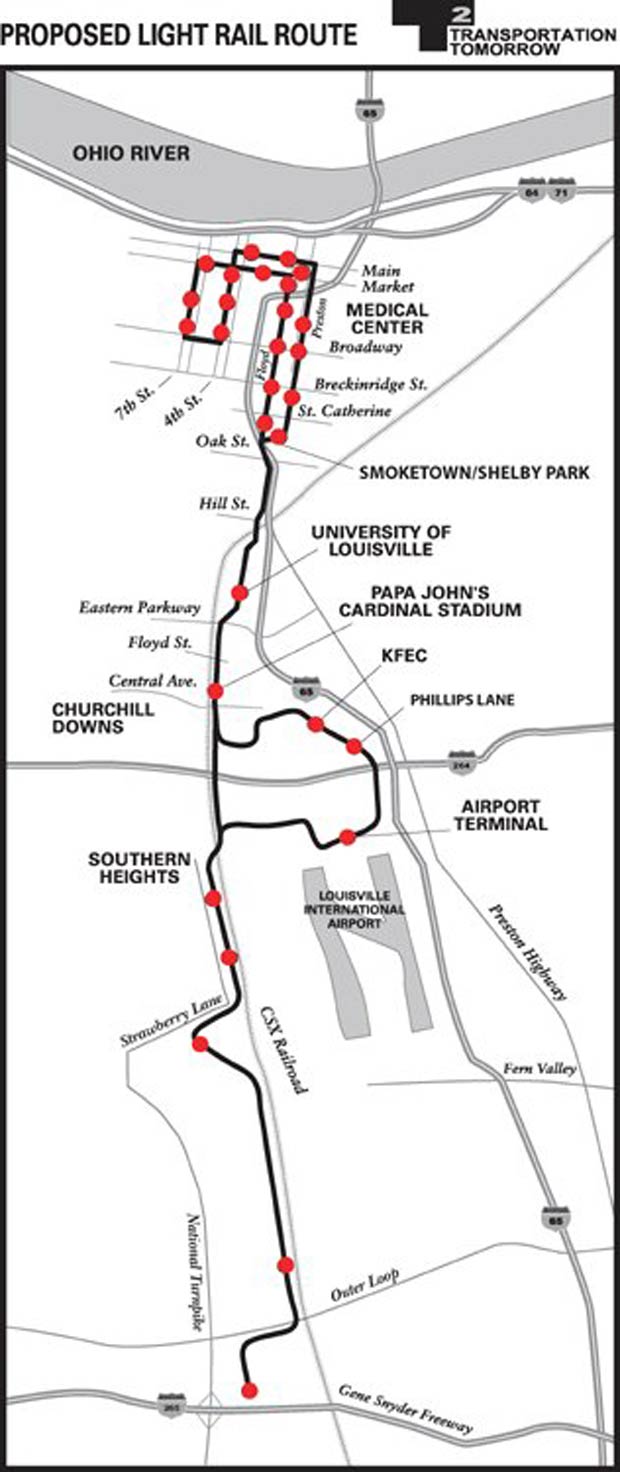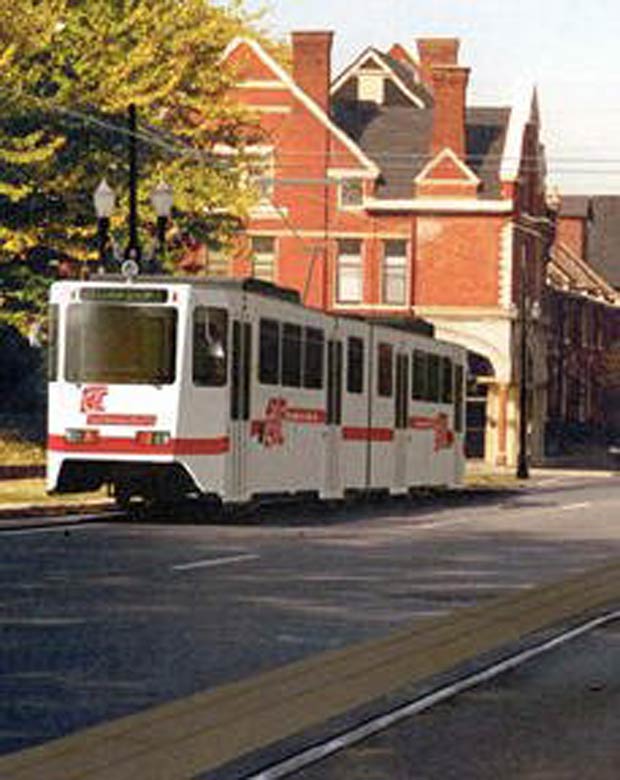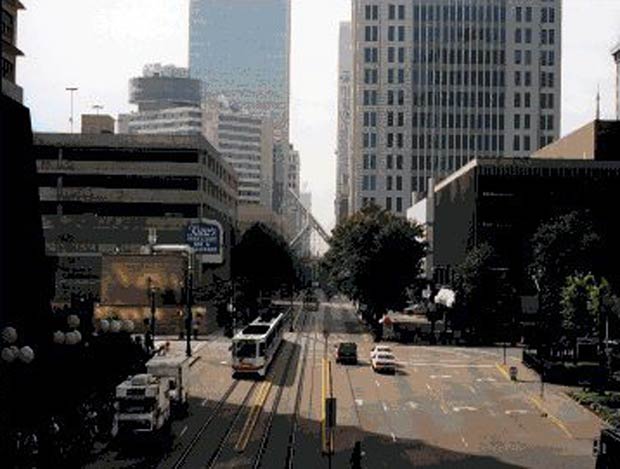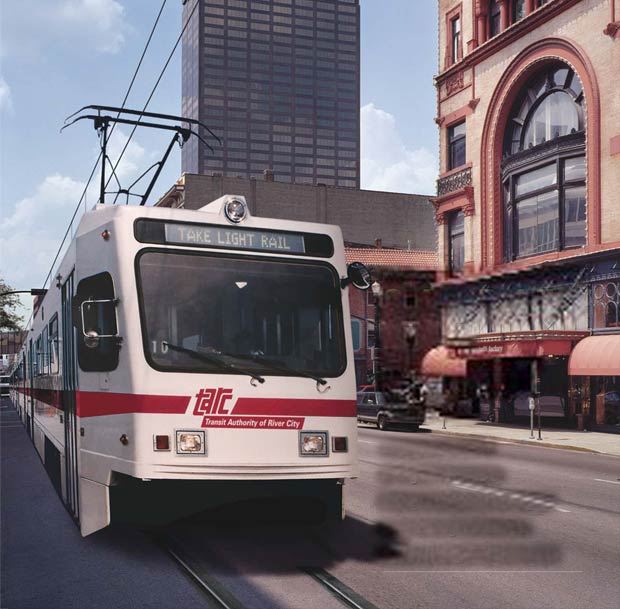
A few readers were discussing Louisville’s old light rail proposal circa 2002 called Transportation Tomorrow (T2), so I decided to post the old renderings and route map in case anyone else needed a refresher.
From the project abstract at the U.S. DOT’s Context Sensitive Solutions site:
Travel and congestion in the South Central Corridor have dramatically increased due to population and employment growth within the Louisville Metropolitan Area (LMA). An important indicator of congestion has been growth in trips on I-65 that neither begin nor end in the LMA, but are “through trips” on the interstate system. The combined travel on I-65 for local, regional and through trips has resulted in slower and less predictable travel times and reduced mobility for many interlocking travel markets in the South Central Corridor. Accessibility to jobs, business establishments, and cultural, entertainment, institutional and public service destinations is deteriorating and is considered a primary limiting factor to social and economic development. Neighborhoods are affected by the diversion of some longer trips to the local street system. Existing bus transit operates in mixed traffic and experiences the same congestion as a private automobile. In most circumstances, the rising congestion penalizes the transit traveler more so than the automobile traveler when both in-vehicle and out-of-vehicle travel times are taken into consideration. Existing transit, therefore, does not, and cannot, effectively compete with the single occupant vehicle (SOV).

But what has happened to the T2 light rail proposal since then? From TARC’s FAQ page: What happened to Light Rail?
The Light Rail project began with a Major Investment Study in 1996. After initial studies and analysis, rapid transit was prioritized over other alternatives and the locally preferred South Central Corridor was selected. The project entered into the Federal New Starts Program, and it was approved as a project in Horizon 2030, the region’s long-range transportation plan. The project then moved into Preliminary Engineering after the FTA issued a ‘recommended’ rating and the draft environmental impact statement was completed. In 2004 – 2006, the FTA implied that the movement into Final Design was not possible without a secured local match and the Draft Environmental Statement was not released for public review. At this point, TARC withdrew the Transportation Tomorrow project from New Starts program due to the inability to secure local funding.




TARC can, and should, let the voters decide if they support this plan:
KRS 96A.330(4) If the governing body of any such public body shall determine that the public welfare requires the establishment of the mass transportation program as proposed by the transit authority, the governing body of such public body may by resolution or ordinance determine that a proposal for the establishment of such mass transportation program shall be submitted to the electorate of the public body. Such resolution or ordinance of the public body shall describe the mass transportation program to be submitted to the electorate, together with the proposed source of funding therefor, which shall be expressed as one of the following:
(a) An ad valorem tax levy expressed as a certain maximum number of cents per each one hundred dollars ($100) of assessed valuation, subject to constitutional limits;
(b) An occupational license tax, subject to the limitations of KRS 96A.310 to 96A.370; or
(c) A sales tax upon all retailers at a rate not to exceed one-half of one percent (0.5%) of the gross receipts of any retailer derived from “retail sales” or “sales at retail” as defined in KRS Chapter 139.
Thanks for the story; I was wondering about T2 just last week. Surely TARC has looked into bus rapid transit as a more affordable way to accomplish the same goals. No mention of that or any future efforts on the FAQ… which, incidentally, is unsatisfying. Surely TARC knew from the dawn of time that FTA would require a local match. How then is that called out as the item that derailed the project?
What are the ballot initiative laws like in Louisville? We should get this on the 2012 ballot!
The Draft Environmental Statement was not released for public review, but I did obtain it a couple months ago via open records request. It’s full of fun observations like this one:
“The I-65 capacity issues cannot be resolved by adding more traffic lanes. The acquisition and clearance of the right-of-way needed would be both costly and damaging to the environment.”
Here’s the summary I uploaded: https://docs.google.com/document/d/1qsW8pFvQvfOBDa6UuU7nOmnF49KDOhiMHFB87saAIHk/edit
They just threw it on a CD for me at no charge and I picked it up, so I’m sure they’d do the same for anyone who wanted to take a peek. Just email jholman@ridetarc.org w/copy of that “What happened to light rail?”-paragraph & the standard golden open records phrase, “Pursuant to the state open records act, I request access to and copies of any official report on…”
When get start kind of Rail Trac Bus?
Let’s get this done on Broadway from Shawnee Park to Baxter Avenue and on 18th Street and Dixie Ave from Nain to the Gene Snyder parkway.
Lightrail for Louisville, Kentucky. But it should connect from the AIRPORT too!